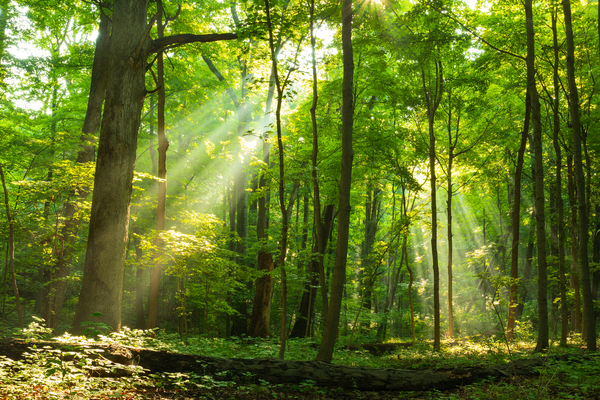Carbon dioxide is a trace gas in the Earth’s atmosphere that contributes to the greenhouse effect, the carbon cycle, photosynthesis, and the oceanic carbon cycle. It is one of several greenhouse gases in the Earth’s atmosphere that are contributing to climate change as greenhouse gas emissions from human activities increase.
Scientists have discovered that when forests first appeared on our planet, the atmosphere contained far less CO2 than previously thought. The new study has important implications for understanding how land plants affect the climate. The study, led by the University of Copenhagen in collaboration with the University of Nottingham, challenges 30 years of previous knowledge. The findings were published in Nature Communications.
It is thought that the early forests that emerged during the Carboniferous period, about 359-299 million years ago, had a limited effect on atmospheric CO2 levels. This is because the rate of photosynthesis in these early forests was likely lower than it is in modern forests due to differences in the composition of the atmosphere at the time.
Additionally, the forests of the Carboniferous period were dominated by trees with upright trunks, which had a lower leaf surface area per unit of woody biomass compared to the trees of today. This would have reduced the overall photosynthetic capacity of these early forests. However, it is worth noting that the growth and spread of forests during the Carboniferous period did play a role in sequestering carbon from the atmosphere and contributing to the formation of coal deposits.
Tall trees and forests colonized the Earth’s continents around 385 million years ago. Shallow shrub-like plants with vascular tissue, stems, shallow roots, and no flowers had previously invaded the land. According to textbooks, the atmosphere at the time had far higher CO2 levels than today, and an intense greenhouse effect resulted in a much warmer climate. Previously, it was thought that the emergence of forests would promote CO2 removal from the atmosphere, causing the Earth to enter a long cool period with ice cover at the poles.
The newly calibrated method to study CO2 levels from the geological record is superior to previous approaches that produce estimates with unbound error bars simply because they rely on parameters that cannot be independently constrained in the geological record.
Barry Lomax
Reconstructing atmospheric CO2 levels in the geological past is difficult and has previously relied on proxies that, in turn, rely on parameters that must be assumed. Climate scientists agree that CO2 has a significant impact on Earth’s climate today and in the past. As a result, understanding what has controlled the abundance of CO2 in the atmosphere is a major challenge for Earth scientists.
“We calibrated a mechanistic model for the gas exchange between plant leaves and the ambient air to the oldest lineage of vascular land plants, namely clubmosses. With this approach, we could calculate the CO2 level in the air solely from observations made on the plant material,” tells associate professor Tais W. Dahl from the Globe institute at the University of Copenhagen, who led the study in collaboration with an international team of researchers from Germany, Saudi Arabia, UK, and USA.
The new method is based on three observations that can be made in both living and fossil plant tissue, including the ratio of two stable carbon isotopes and the size and density of stomata (pore openings) through which CO2 is taken up by the plant. The researchers calibrated the method in living clubmosses and discovered that it can accurately reproduce ambient CO2 levels in the greenhouse.
“The newly calibrated method to study CO2 levels from the geological record is superior to previous approaches that produce estimates with unbound error bars simply because they rely on parameters that cannot be independently constrained in the geological record,” says Barry Lomax, a co-author on the study.

The method was applied to some of the oldest vascular plant fossils that lived before and after trees evolved on our planet, and the researchers discovered that the ratio of the two stable carbon isotopes, carbon-13 and carbon-12, is very similar to that of modern plants. Furthermore, the density and size of the stomata were very similar to that observed in their living descendants. These findings sparked a more in-depth investigation of the early CO2 record.
Dahl and colleagues collected data from 66 fossils of three distinct species of club mosses found in 9 different localities worldwide 410 to 380 million years in age. In all cases, the atmospheric CO2 levels were only 30-70% higher (~525 – 715 ppm) than today (~415 ppm). This is far lower than previously thought (2000-8000 ppm). Ppm stands for parts-per-million and is the unit used to measure carbon dioxide concentrations in air.
The team utilized a paleoclimate model to show that Earth was a temperate planet with mean tropical surface air temperatures of 24.1-24.6°C.
“We used a fully coupled atmosphere-ocean model to find that Earth had ice-covered poles when forests emerged. Yet, land plants could thrive in the tropical, subtropical, and temperate zones,” explains Georg Feulner from the Potsdam Institute for Climate in Germany, who co-authored the study.
According to the new study, trees have a negligible effect on atmospheric CO2 levels over longer time scales because early trees had deeper root systems and produced more developed soils, which are associated with lower nutrient loss. Trees have a lower weathering demand than the shallow shrub-like vegetation that came before them due to more efficient nutrient recycling in soils. This idea contradicts previous beliefs that trees with deeper root systems promoted CO2 removal through enhanced chemical weathering and silicate rock dissolution.
Dahl and colleagues used Earth system models to show that when primitive shrub-like vascular plants first spread across the continents, they could have caused a massive drop in atmospheric CO2. The model shows that the vascular ecosystem would have simultaneously led to a rise in atmospheric O2 levels.
















